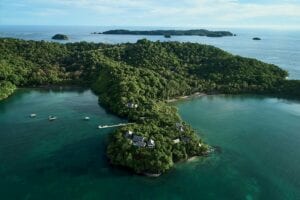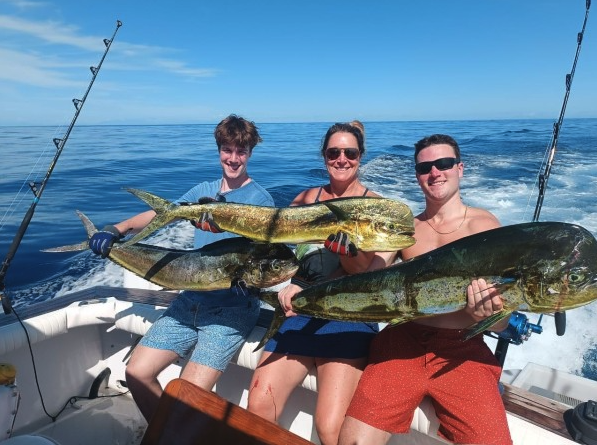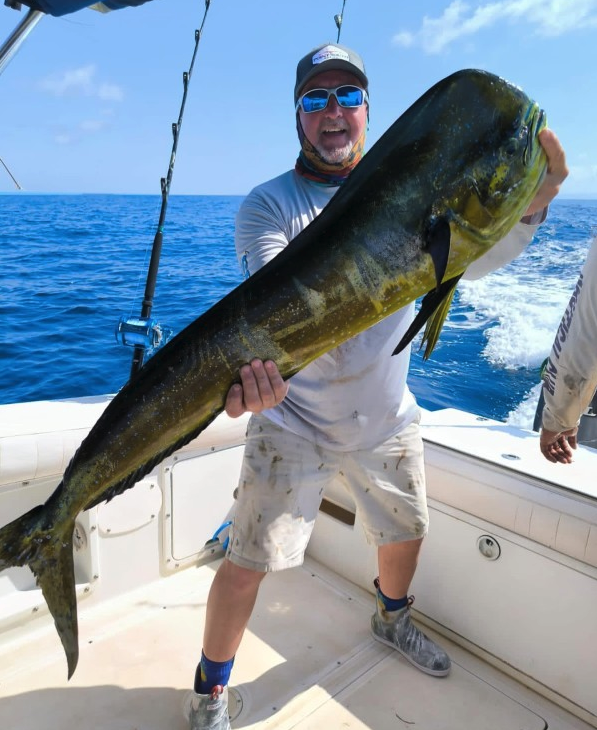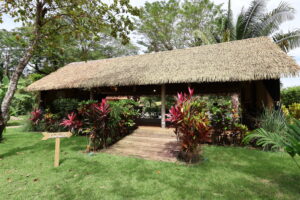
Islands in Panama Worth Visiting
Offering an unparalleled escape into nature’s lap nestled in the pristine surroundings that mirror the famed beauty of Islas Secas.
Mahi Mahi fish is scientifically known as Coryphaena hippurus and popularly referred to as dorado or dolphinfish. They are vibrant and highly sought-after by anglers around the globe for its unique characteristics, their habitats and culinary benefits, making them an ideal catch for your next offshore fishing adventure.
Mahi mahi, known for their striking appearance, exhibits a vibrant color palette that includes dynamic shades of yellow, green, and brilliant blue. These vivid colors are special cells that change color in response to environmental and emotional stimuli. For instance, when mahi-mahi are calm and swimming leisurely, they typically display a deep yellow hue underwater. However, when excited or agitated, such as during feeding or when hooked, these fish can suddenly flash vibrant neon blue, creating a spectacular display. This rapid color change not only serves as a communication tool among mahi-mahi but also plays a role in predator evasion.

Shape:
The physical shape of mahi-mahi is quite distinctive. They have compressed, streamlined bodies that enhance their hydrodynamics, allowing for swift movement through water. A remarkable feature is their long, continuous dorsal fin, which runs from above the head nearly to the tail, aiding in sharp turns and sudden movements. Male mahis are usually displaying prominently square-shaped, almost vertical foreheads. Females, in contrast, have more gently sloping, rounded foreheads. This difference becomes more noticeable as they mature and contribute to their mating rituals and dynamics.
The size and weight of mahi-mahis can vary significantly, influenced by factors like availability of food and habitat conditions. While they commonly weigh between 15 to 30 pounds, they can achieve weights of up to 50 pounds in ideal conditions. For context, the International Game Fish Association (IGFA) records the largest mahi mahi caught on rod and reel at around 87 pounds, which was caught off the coast of Costa Rica in 1976.
Mahi-mahi are among the fastest-growing fish in the ocean, which contributes significantly to their popularity in sustainable fishing practices. Typically, they have a lifespan of 4 to 5 years. Remarkably, they reach sexual maturity at just 5 months old and are capable of reproducing year-round. This rapid maturity allows for continuous population replenishment, which is crucial given their popularity with both commercial and recreational fishermen.
Mahi-mahi have several names across different regions, reflecting cultural influences and local languages. In the Pacific the name “Mahi-Mahi,” means “very strong” in Hawaiian, reflecting the fish’s vigorous nature. In the Atlantic, they are often called dolphin or dolphinfish. In Spanish-speaking regions, they are named “dorado,” which translates to “golden.”
Mahi mahi thrive in warm, tropical, and subtropical waters across the globe, especially common in areas like the west coast of North and South America, the Pacific coasts of Panama and Costa Rica, the Gulf of Mexico, the Indian Ocean, Southeast Asia, and around Hawaii. These environments provide the warm temperatures that mahi mahi thrive in.
These pelagic fish prefer the open ocean, rather than close to the sea floor or coastal areas, often congregating around floating objects like wood, palm fronds, and sargasso weed lines, which attract smaller baitfish making them ideal places for mahi mahi to hunt.

Seasonality – Best time to Fish for Mahi Mahi or Dolphinfish
In Central America, mahi mahi can be caught all year round, making them a popular target for both commercial and recreational fishing. However, there are certain times of the year when the chances of catching larger mahi-mahi increase. The period from April through September is particularly favorable due to the warmer temperatures of the water.
Additionally, the rainy season, which typically starts in April and continues through September, contributes to better mahi mahi fishing conditions. The heavy rains wash various forms of debris from the land into the ocean, including leaves, branches, and other organic materials. These debris flows create new floating structures in the open water, which attract small marine organisms that in turn attract hungry mahi mahi. As a result, these months see an increase in mahi mahi activity around these floating debris fields, offering anglers a better chance of a successful catch.
Understanding these habitat preferences and seasonal patterns can greatly enhance your chances of successfully finding and catching mahi mahi, especially if you are planning a fishing trip in regions known for their presence.
Dorado are aggressive predators, feasting on small fish, squid, crabs, and shrimp. They are known for their speed, reaching up to 55 miles per hour, which they use to chase down prey.
Using lively mackerel, ballyhoo, or sardines can be extremely effective in attracting Dorado.
Lures that mimic small squid or flying fish in greens, blues, and yellows are particularly effective due to their mahi mahi’s hunting prowess.
This method is ideal for mimicking the movements of mahi mahi’s natural prey. Adjust your trolling speed to match the conditions and the behavior of the fish for optimal results.
Floating structures in the ocean are hotspots for mahi mahi as they attract schools of smaller fish. Fishing near these natural fish aggregators can significantly increase your chances of a successful catch.
Mahi-Mahi has a lean, moderately firm texture with a mild, slightly sweet flavor that is less “fishy” than some other species like mackerel or sardines. Mahi-mahi’s flesh holds together well during cooking, offering a moderately firm consistency, predominantly described as having an umami flavor profile, which is both savory and satisfying.
Mahi mahi is highly nutritious, making it an excellent addition to a healthy diet. It is a fantastic source of high-quality, lean protein which is crucial for muscle repair and growth. Additionally, it is low in saturated fats, which helps to maintain heart health and overall well-being. It is also abundant in omega-3 fatty acids, known for their benefits in reducing inflammation and supporting cardiovascular health.
Furthermore, mahi mahi provides several vital nutrients:
Mahi mahi’s mercury levels are comparatively low among seafood, which makes it a safer choice for frequent consumption, including for pregnant women and children in moderation, following general seafood consumption guidelines.
The versatility of mahi mahi in culinary preparations is vast. Here are some common methods to bring out the best in its flavor:
Panama’s Pacific coast is an excellent spot for mahi mahi fishing. Our fishing brand, Panama Nautical Club offers close access to prime offshore fishing grounds. Our experienced captains are skilled in various techniques that maximize your chances of a successful catch.
Join us for an unforgettable sportfishing adventure from start to finish.


Offering an unparalleled escape into nature’s lap nestled in the pristine surroundings that mirror the famed beauty of Islas Secas.

A Top Resort with Yoga Retreat that not only promises relaxation but also a profound connection with yourself and the environment.

Luxury Panama Island Resort with adventures and yoga, that not only promises relaxation but also a profound connection with yourself and the environment.
Get in touch
We accept
Visa, Mastercard, Crypto (Bitcoin, Ethereum and UDSC/USDT)
Visa, Mastercard, Wire, Crypto (Bitcoin, Ethereum and UDSC)